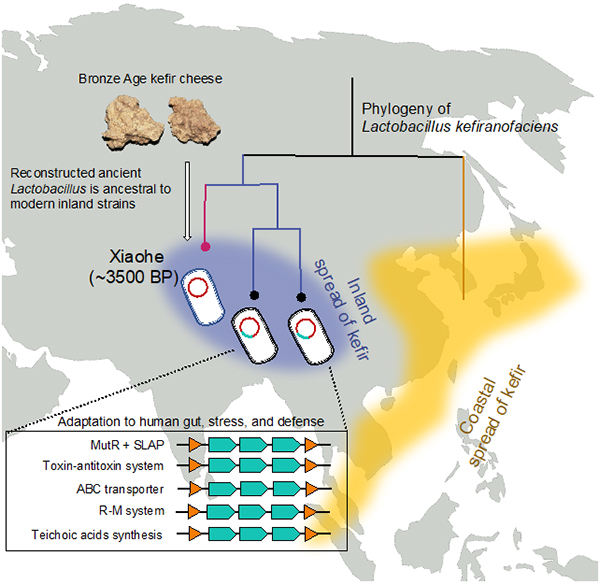

The transmission route and evolutionary history of Lactobacillus plantarum.
The orange area represents the route of propagation along the coastline from the
Caucasus region; The purple area represents the inland transmission route of the
subspecies branch of Lactobacillus plantarum, with the Xinjiang strain from 3500
years ago located at the base of this branch
Food fermentation is the oldest practice in human history that utilizes
microorganisms for production, and fermented dairy products may be the earliest
fermented food. However, despite the long history of human consumption of
fermented dairy products, little is known about how humans apply, spread, and
domesticate fermented microorganisms, as well as how microorganisms co evolve
and mutually benefit with humans.
Under the long-term support of the National Natural Science Foundation of
China (Grant No.: 41925009), the team of Fu Qiaomei from the Institute of
Vertebrate Paleontology and Paleoanthropology of the Chinese Academy of Sciences
has independently developed capture probes for 11 years, obtained high-quality
Kefir lactic acid bacteria genome 3500 years ago from the world's oldest cheese,
and achieved the first global genome research of ancient fermentation
microorganisms. The results show that, unlike the transmission route along the
coastline from the Caucasus region, the ancient Xinjiang Kefir lactic acid
bacteria are located at the base of the East Asian inland branch, revealing
another independent new transmission route of Kefir lactic acid bacteria and
related fermentation technology from Xinjiang to the interior of East Asia,
which provides unique genetic evidence for clarifying the lifestyle of ancient
people in the Tarim Basin, Xinjiang, and the exchange of technology and culture.
In addition, research has found that over the past few thousand years,
functional genes related to drug resistance mechanisms, bacterial autoimmunity,
and alleviation of human intestinal inflammation in Kefir lactobacilli have
evolved. This is the result of the adaptive evolution of the strain itself and
the combined effects of long-term human preference domestication. This discovery
reveals the molecular mechanisms of coevolution and mutualistic symbiosis
between humans and lactic acid bacteria on an evolutionary timescale, which has
important scientific significance for a deeper understanding of the complex
interactions between humans and microorganisms, the formation mechanism of
genetic diversity in symbiotic microorganisms, and the evolution of modern
microbial resistance genes.
This achievement, titled "Bronze Age cheese reveals human Lactobacillus
interactions over evolutionary history", was published in the journal Cell on
September 25, 2024. It was praised by Harvard professors as "opening up a new
frontier in ancient DNA research" and was recently selected as the Best of Cell
2024 research paper.